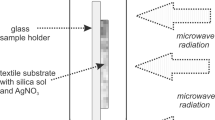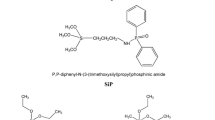Abstract
Chitosan is a natural-based polymer produced by deacetylation of chitin. Chitosan is often claimed to contain antimicrobial properties. The application of modified sol−gel coatings is a well-known technique to realize functional textiles. The combination of both silica sols and chitosan is used in the current study for textile coatings with a view on hydrophilic, antistatic and antimicrobial properties. For this, two different types of chitosan are applied in combination with two different types of silica sols. Both silica sols are water based and of acidic nature, due to the solubility of chitosan in acidic liquids. One silica sol is originated by hydrolysis from tetraethoxysilane (TEOS). For the other silica sol, besides TEOS, additionally 3-glycidyloxypropyltriethoxysilane (GLYEO) is used as a precursor. The solid content of the used sols is around 3 wt%. The concentration of chitosan is set in the range of 0.03−0.3 wt%. Coatings are applied on cotton and polyester fabrics. Scanning electron microscopy (SEM) is used for the investigation of sample topography. Finally, the hydrophilic properties of the fabrics are significantly decreased, while antistatic and antimicrobial properties are hardly affected at all by chitosan.

Highlights
-
Silica/chitosan coatings provide hydrophilic properties to hydrophobic textiles, such as polyester.
-
Silica/chitosan coatings provide hydrophobic properties to hydrophilic textiles, such as cotton.
-
The hydrophilic/hydrophobic properties of textiles can be switched.
-
An influence on the bacterial growth can be stated, however, with no significant antibacterial effect.











Similar content being viewed by others
References
Mahltig B (2018) Textiles: advances in research and applications. Nova Science Publishers, New York
Mahltig B, Böttcher H (2003) Modified silica sol coatings for water-repellent textiles. J Sol-Gel Sci Technol 27:43–52
Mahltig B, Haufe H, Böttcher H (2005) Functionalization of textiles by inorganic sol-gel coatings. J Mater Chem 15:4385–4398
Mahltig B, Textor T (2008) Nanosols and textiles. World Scientific, Singapore
Jiang C, Liu W, Yang M, He S, Xie Y, Wang Z (2018) Synthesis of superhydrophobic fluoro-containing silica sol coatings for cotton textile by one-step sol–gel process. J Sol-Gel Sci Technol 87:455–463
Kucuk M, Ovecoglu ML (2018) Surface modification and characterization of polyester fabric by coating with low temperature synthesized ZnO nanorods. J Sol-Gel Sci Technol 88:345–358
Ismail WNW (2016) Sol–gel technology for innovative fabric finishing—a review. J Sol-Gel Sci Technol 78:698–707
Mahltig B, Fiedler D, Simon P (2011) Silver containing sol-gel coatings on textiles. J Textile Institute 102:739–745
Xing Y, Yang X, Dai J (2007) Antimicrobial finishing of cotton textile based on water glass by sol–gel method. J. Sol-Gel Sci Technol 43:187–192
Klemenčič D, Tomšič B, Kovač F, Žerjav M, Simončič A, Simončič B (2013) Antimicrobial wool, polyester and a wool/polyester blend created by silver particles embedded in a silica matrix. Coll Surf B111:517–522
Soltmann U (2008) Utilization of sol–gel ceramics for the immobilization of living microorganisms. J Sol-Gel Sci Technol 48:66–72
Coradin T, Livage J (2003) Synthesis and characterization of alginate/silica biocomposites. J Sol-Gel Sci Technol 26:1165–1168
Witoon T, Chareonpanich M, Limtrakul J (2009) Effect of acidity on the formation of silica–chitosan hybrid materials and thermal conductive property. J Sol-Gel Sci Technol 51:146–152
Lim S-H, Hudson SM (2003) Review of chitosan and its derivatives as antimicrobial agents and their uses as textile chemicals. J Macromol Sci C43:223–269
No HK, Park NY, Lee SH, Meyers SP (2002) Antibacterial activity of chitosans and chitosan oligomers with different molecular weights. Int J Food Microbiol 74:65–72
Zheng LY, Zhu JF (2003) Study on antimicrobial activity of chitosan with different molecular weights. Carbohydrate Polym 54:527–530
Sahariah P, Másson M (2017) Antimicrobial chitosan and chitosan derivatives: a review of the structure–activity relationship. Biomacromolecules 18:3846–3868
Bhuiyan MR, Hossain MA, Zakaria M, Islam MN, Uddin MZ (2017) Chitosan coated cotton fiber: physical and antimicrobial properties for apparel use. J Polym Environ 25:334–342
Lubick N (2008) Nanosilver toxicity. Environ Sci Technol 42:8617
Mahltig B, Böttcher H, Knittel D, Schollmeyer E (2004) Light fading and wash fastness of dyed nanosol-coated textiles. Textile Res J 74:521–527
Mahltig B, Knittel D, Schollmeyer E, Böttcher H (2004) Incorporation of triarylmethane dyes into sol-gel matrices deposited on textiles. J Sol-Gel Sci Technol 31:293–297
Mahltig B, Textor T (2006) Combination of silica sol and dyes on textiles. J Sol-Gel Sci Technol 39:111–118
Flesner J, Mahltig B (2017) In: Thakur VK, Thakur MK, Kessler MR (eds) Handbook of composites from renewable materials. Scrivener Publishing LLC Wiley, New Jersey
Choudhury AKR (2006) Textile preparation and dyeing. Science Publishers, Enfield
Jakubke H-D, Jeschkeit H (1993) Concise encyclopedia chemistry. Walter de Gruyter, Berlin
Mahltig B, Fischer A (2010) Inorganic/organic polymer coatings for textiles to realize water repellent and antimicrobial properties. J Polym Sci B: Polym Phys 48:1562–1568
Mahltig B, Fiedler D, Fischer A, Simon P (2010) Antimicrobial coatings on textiles—modification of sol-gel layers with organic and inorganic biocides. J Sol-Gel Sci Technol 55:269–277
Bahners T (2011) The do’s and don’ts of wettability characterization in textiles. J Adhesion Sci Technol 25:2005–2021
Colliex C (2008) Elektronenmikroskopie. Wissenschaftliche Verlagsgesellschaft mbH, Stuttgart
Kaltenberg J, Plum LM, Ober-Blöbaum JL, Hönscheid A, Rink L, Haase H (2010) Zinc signals promote IL‐2‐dependent proliferation of T cells. Eur J Immunol 40:1496–1503
Mahltig B, Reibold M, Gutmann E, Textor T, Gutmann J, Haufe H, Haase H (2011) Preparation of silver nanoparticles suitable for textile finishing processes to produce textiles with strong antibacterial properties against different bacteria types. Z Naturforsch B—Chem Sci 66B:905–916
Schottner G (2001) Hybrid sol−gel derived polymers. Chem Mater 13:3422–3455
Schramm C, Binder WH, Tessadri R (2004) Durable press finishing of cotton fabric with butanetetracarboxylic acid and TEOS/GPTMS. J Sol-Gel Sci Technol 29:155–165
Behr D (1991) Was versteht man unter elektrischer Aufladung. Wirkerei und Strickereitechnik 41:7
Bhat NV, Benjamin YN (1999) Surface resistivity behavior of plasma treated and plasma grafted cotton and polyester fabrics. Textile Res J 69:38–42
Textor T, Mahltig B (2010) A sol-gel-based surface treatment for preparation of water repellent antistatic textiles. Appl Surf Sci 256:1668–1674
Krüger R, Bockmeyer MJ, Dutschke A, Löbmann PC (2006) Continuous sol−gel coating of ceramic multifilaments. J Am Chem Soc 89:2080–2088
Windler L, Lorenz C, von Goetz N, Hungerbühler K, Amberg M, Heuberger M, Nowack B (2012) Release of titanium dioxide from textile during washing. Environ Sci Technol 46:8181–8188
Raafat D, Sahl H-G (2009) Chitosan and its antimicrobial potential—a critical literature survey. Microbial Biotechnol 2:186–201
Tsai G-J, Su W-H (1999) Antibacterial activity of shrimp chitosan against Escherichia coli. J Food Protection 62:239–243
Acknowledgements
The authors would like to thank Mr. Thomas Heistermann and Dr. Thomas Grethe for their help in the lab and many helpful discussions. Some presented results are part of the master thesis of Gaoshi Chen performed at the Hochschule Niederrhein (Faculty of Textile and Clothing Technology) in summer 2018.
Author information
Authors and Affiliations
Corresponding author
Ethics declarations
Conflict of interest
The authors declare that they have no conflict of interest.
Ethical statement
By this I state, as the corresponding author, that this paper does not disclose any information of potential conflicts of interest and does not contain any research involving human participants and/or animals. The data shown are originally determined and measured in our laboratories.
Additional information
Publisher’s note: Springer Nature remains neutral with regard to jurisdictional claims in published maps and institutional affiliations.
Rights and permissions
About this article
Cite this article
Chen, G., Haase, H. & Mahltig, B. Chitosan-modified silica sol applications for the treatment of textile fabrics: a view on hydrophilic, antistatic and antimicrobial properties. J Sol-Gel Sci Technol 91, 461–470 (2019). https://doi.org/10.1007/s10971-019-05046-8
Received:
Accepted:
Published:
Issue Date:
DOI: https://doi.org/10.1007/s10971-019-05046-8




